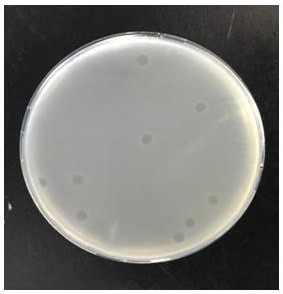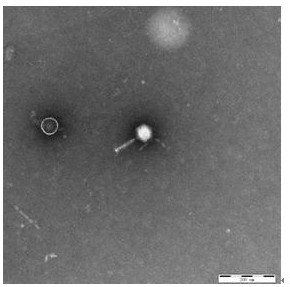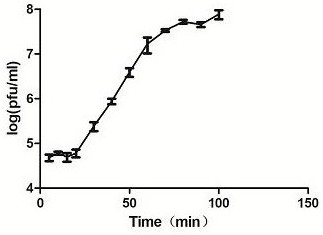Bacteriophage vB_Yen_X1 and application thereof in prevention and treatment of Yersinia pestis infestation
A phage, Yersinia technology, applied in the field of bioengineering, can solve problems such as narrow bactericidal spectrum
- Summary
- Abstract
- Description
- Claims
- Application Information
AI Technical Summary
Problems solved by technology
Method used
Image
Examples
Embodiment 1
[0018] Phage isolation and preparation
[0019] The fecal liquid sewage sample in the present invention is collected from Huoshao Li Sewage Ditch in Changchun City; the host bacteria is Yersinia enterocolitica 23715. Collect sewage, filter it with gauze, or centrifuge at 6000 g / min for 10 min, and take the supernatant; replace ddH with treated sewage 2 O Prepare Yersinia enterocolitica expansion medium (sodium chloride 0.5 g, tryptone 0.5 g, beef extract powder 0.4 g) (100 mL); take 1 mL of the overnight cultured bacterial solution, mix it, and shake In bed (37°C, 165 r / min overnight culture); take 1 mL of overnight culture, centrifuge at 12,000 g / min for 5 min, filter the supernatant with a 0.22 µm filter to form a phage stock solution and save it, and use the obtained filtrate for the spot test , to check whether the phage stock contains phages capable of killing Yersinia enterocolitica.
[0020] The plaque test was performed as follows: Yersinia enterocolitica 23715 was i...
Embodiment 2
[0024] Phage amplification and purification
[0025] On the double-layer plate forming plaques, use a sterile pipette tip to pick up a single plaque with a large diameter, round and translucent, and inoculate it in 5 mL of Yersinia enterocolitica expansion culture Add 200 µL of phage host bacterial solution to the base, mix well, incubate at room temperature for 15 min, incubate at 37°C for 10-14 h, centrifuge at 12,000 g, 4°C for 10 min, and take the supernatant; repeat the double-layer plate experiment 4-5 times, In this way, single phage plaques were picked repeatedly 4-5 times, and the phages were purified into phage plaques of the same size.
[0026] Take 1 mL of freshly cultured host bacteria and add 300 µL of phage lysate (the ratio of a single phage culture to host bacteria is 1:1, 1:10 and 1:100, respectively). Incubate at 37°C for 20 min to make the phage particles adsorb to the host bacteria; add 800 mL Yersinia enterocolitica amplification medium, and then add CaC...
Embodiment 3
[0035] Transmission electron microscope observation of bacteriophage vB_Yen_X1
[0036] Take the PEG-purified phage in Example 2 for electron microscope observation. The specific operation steps are: add 10 µL of sample and drop it on the copper grid, wait for it to settle for 15 min, absorb excess liquid with filter paper, and use 2% phosphotungstic acid (PTA ) stained for 1-2 min, and observed with a transmission electron microscope (Hitachi H-7650) after drying; the observation results are as follows figure 2 As shown, the head is in the shape of an icosahedron, the diameter of the head is about 64 nm, and the length of the tail is about 94 nm. According to the "Classification of Viruses—The Eighth Report of the International Committee on Taxonomy of Viruses" published by the International Committee on Taxonomy of Viruses (ICTV) in 2005, vB_Yen_X1 belongs to the family Myoviridae.
PUM
 Login to View More
Login to View More Abstract
Description
Claims
Application Information
 Login to View More
Login to View More - R&D
- Intellectual Property
- Life Sciences
- Materials
- Tech Scout
- Unparalleled Data Quality
- Higher Quality Content
- 60% Fewer Hallucinations
Browse by: Latest US Patents, China's latest patents, Technical Efficacy Thesaurus, Application Domain, Technology Topic, Popular Technical Reports.
© 2025 PatSnap. All rights reserved.Legal|Privacy policy|Modern Slavery Act Transparency Statement|Sitemap|About US| Contact US: help@patsnap.com



